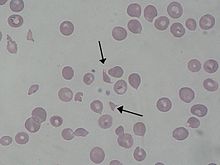- Schistocyte
-
A schistocyte or schizocyte (from Greek schistos for "divided" or schistein for "to split", and kytos for "hollow" or "cell") is a fragmented part of a red blood cell. Schistocytes are typically irregularly shaped, jagged, and asymmetrical. A true schistocyte does not have central pallor. [1] Schistocytes are sometimes referred to as "helmet cells."
Several microangiopathic diseases, including disseminated intravascular coagulation and thrombotic microangiopathies, generate fibrin strands that sever red blood cells as they try to move past a thrombus, creating schistocytes.
Schistocytes are often seen in patients with hemolytic anemia. They are frequently a consequence of mechanical heart valve prostheses. (See artificial heart valve)
Excessive schistocytes present in blood can be a sign of microangiopathic hemolytic anemia (MAHA) where the most common cause is aortic stenosis.
References
Lymphocytes Small molecules- ^ Amanda Cox et al., Schistocytes: A Brief Overview. Retrieved 23 August 2008.
ProteinsNitrogenous
Minerals Pathogens/sepsisOtherCategories:- Pathology stubs
- Abnormal clinical and laboratory findings for RBCs
Wikimedia Foundation. 2010.

